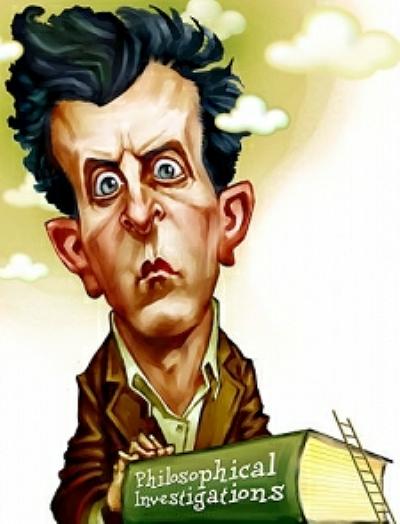A Jamesian Wittgenstein?
A former professor of mine, Haim Marantz, sent me a paper of his on Richard Rorty and another on John Dewey recently for some comments. I have never been much for American Pragmatism, not since, as an undergraduate, I read a bit of William James and John Dewey and thought them somewhat soft as thinkers. I also concluded, probably because of the way an instructor at the time presented the two, that American Pragmatism really amounted to an argument that the truth is just whatever works and that's the whole story. This just seemed superficial and wrong to me and I gravitated, instead, to what seemed the more rigorous Analytic tradition in England. Later, I discovered Wittgenstein and his approach opened things up for me in a way that made analytic philosophy seem rather limited, too. I learned, eventually, that Wittgenstein was not well read in philosophy however, although he apparently liked Schopenhauer (at least in his youth) and, at some point in his career, had read William James. That surprised me because it seemed to me that there was a huge gap between James' seemingly superficial pragmatic vision of philosophy and Wittgenstein's penetrating understanding of how language shapes and reflects the way we understand things. Yet, years later I discovered that more and more thinkers were finding in Wittgenstein a pragmatic strain linking him firmly to the work of people like James, especially in light of his almost off-hand remark about 'meaning as use' (Philosophical Investigations). This approach forms the basis for understanding semantics in pragmatic terms, an approach to meaning in language that has taken hold in later Anglo-American philosophical thought. Marantz' papers reminded me of all this and were suggestive, as well, in their treatment of Rorty and Dewey.
A number of modern thinkers, Robert Brandom among them, have argued that Wittgenstein in fact stands in a long tradition of pragmatists going back at least as far as Kant and coming up through Hegel to the classic American Pragmatists (Peirce, James and Dewey) and flowering in the efforts of Wittgenstein and Heidegger (no less!) to find a modern voice in the work of people like the American philosophers Wilfrid Sellars and Richard Rorty. Pragmatism was back -- indeed if Brandom is right, it never left us. Only some, like me, had failed to notice. A year ago I picked up a book in a used book store by William James. Two books actually in one volume: Pragmatism and The Meaning of Truth. This volume, with an introduction by A.J. Ayer, consolidates two sets of lectures delivered by James, the first set in Boston as the Lowell Lectures in 1906 and later at Columbia University (with some slight changes according to Ayer) in 1907. The first set was published in 1907 as Pragmatism. The text of that work forms the first part of the volume I bought, which I finally started reading just a few weeks ago. To my surprise, it contains elements which anticipate and predate Wittgenstein's influential On Certainty. In fact, some of the similarities are astounding.
Writing in the chapter titled Pragmatism's Conception of Truth, James affects to describe how we know things to be the case. He makes the point that knowledge is not strictly what we have evidence for but what fits within a system of things we believe and which touch ground only here and there in instances of empirical verification. Knowledge, he says, involves statements we take to be the case because they work within the larger system of beliefs (all those knowledge claims we are prone to make) in a way that does not disrupt that larger system and which may add to it. In the adding there may be changes made, of course, but it's the overall system of interlocking thoughts (beliefs about things) which is at issue in every instance of knowledge we acquire or think we possess.
Verification matters (as Ayer reminds us in the introduction) but it is not on verification in some isolated sense that our knowledge rests but on the overall effectiveness of the system of ideas we learn from those around us -- who have that particular system, for their part, from those who came before them -- and to which we add as we go through our own lives, all of which combine to form the framework of thoughts we hold at any given moment. The truth of any single claim or belief that we hold, of any statement we make, is determined, per James, by its capacity to add to and/or detract as little as possible from the system of interlocking ideas we already possess. That system, on this Jamesian view is constantly put to the test and it is the system, not the individual statements within it, that must stand up to empirical verification.
James' critics (among whom I, in my naivete, was no doubt one, though of no significance for his actual reputation, of course!) took him to mean by this that the particular verification of any statement of belief is irrelevant because all hinges on what the user of the statements wants out of his or her life and so what he or she wants to believe. Truth is what works, on this somewhat simplistic interpretation, i.e., what becomes truth for us is whatever we want it to be because it satisfies our needs of the moment -- and so the possibility of independent truth, of facts that compel us (because that's just how things are) rather than the other way round, is denied. But that wasn't James' view, it turns out, at all. In fact, he argued that the real world invariably compels us, but that the truth claims we make are not simply a function of that compulsion qua immediate empirical feedback but, rather, of overall systemic success -- where success is constituted by the capacity of our entire body of beliefs (or relevant portions thereof) to advance our interests as users of that body of beliefs. The extent to which any particular belief we happen to hold, or arrive at, fits the proximate instance of experience we undergo (and which may prompt us to that belief) is then determined by the ability of that belief to operate successfully within our overall belief system, either to reinforce its efficacy or change it in a way that makes it more efficacious still (or at least does not make it less so). This set of relations between each new statement of belief and those which precede it, and into which it is obliged to fit, governs the truth value we assign to the new belief.
On the Jamesian view, truth is what we ascribe to statements (and to the beliefs they embody). It's not something in the world to be known, not something that somehow underlies the world we experience (as the transcendental rationalists of his era, and against whom he argued, held). Truth, he thought, is valuational (normative, as Brandom would later put it), the truth of any statement being determined by that statement's capacity to support the body of all the other beliefs we hold in a way that sustains their effectiveness (by disrupting them as little as possible or by introducing changes to them which enhance their effectiveness for the entity holding them). This view is far more sophisticated than I had once given James and the other pragmatists credit for. But that only shows my own naivete I suppose. Even more interesting, it turns out, is that James in these lectures actually presaged Wittgenstein's own insights in the latter's On Certainty, sometimes in an eerily familiar way.
James wrote in his sixth lecture in that series (Pragmatism's Conception of Truth, p.99):
Just as we assume Japan to exist without ever having been there, because it works to do so, everything we know conspiring with the belief, and nothing interfering, so we assume that thing to be a clock [here he refers to a clock on the wall in the lecture hall in which he is speaking]. We use it as a clock, regulating the length of our lecture by it. The verification of the assumption here means its leading to no frustration or contradiction. Verifiability of wheels and weights and pendulum is as good as verification. For one truth-process completed there are a million in our lives that function in this state of nascency. They turn us towards direct verification; lead us into the surroundings of the objects they envisage; and then, if everything runs on harmoniously, we are so sure that verification is possible that we omit it, and are usually justified by all that happens.
Though he could not see the inner workings of that clock on the wall he reminded his audience that he was justified in taking it to be what it appeared to be, a clock, and not merely an artifact with certain external appearances, and so to rely on its readings as he gauged the time remaining in his lecture. As Wittgenstein spoke later of knowledge of things in other places which we cannot see but take on faith, holding these, as if naively (i.e., without observational warrant), to be known with certainty, so James speaks here of the existence of Japan and the innards of a clock in just the same way. For James, as for the later Wittgenstein, being certain of something is not merely a function of having evidence to hand. It's much deeper and more complicated.
This Jamesian pragmatism presumes that the world in which we operate is constituted as much by the ideas and beliefs we hold about it as by the sensible phenomena which, as he puts it, "coerce" us. The knowledge we profess to have about it is as much a function of how we approach and make use of the world of sense as of how it reflects those particular sensory phenomena in a representational way. Contrary to the Tractarian Wittgenstein's picture theory of language, James offers a picture of a dynamic system of thoughts about the world (beliefs) which we build up and which informs our discourse, which is, in fact, embodied in our discourse and so shapes what we see around us -- as surely as that which we see shapes us by "coercion."
"Agreement" between the sensory features of our world and our beliefs about them is not, on this view, the building blocks of our knowledge but its ground -- new information arising only in contact with the world of the senses, here and there, when verifiability (the potential to verify) becomes, as James puts it, actual verification (realized instances of verifying) which only occurs piecemeal in our lives, when our system of beliefs touch ground. Most of our knowledge, including those pre-existing beliefs which govern, by selection, what new knowledge we may acquire, is embodied, for James, in what we have learned as we come of age within the cultural milieu in which we happen to stand. But that body of knowledge is dynamic. It's ever growing and ever changing with each new instance of contact with the phenomenal world.
All of this pre-dates the later Wittgenstein of the Philosophical Investigations and On Certainty, when his shift from the picture theory of language in the Tractatus to the idea that language constitutes the world we know in its rules and the uses they govern becomes paramount. James got there first, more than half a century earlier in fact, and Wittgenstein's having read James must suggest his debt to the earlier thinker. If Wittgenstein's emphasis on the place and role of language in philosophical discourse was innovative in its way, and eye opening, James was already touching on the same phenomena as far back as 1907 and earlier.
 A. J. Ayer,
A. J. Ayer,  C. S. Peirce,
C. S. Peirce,  Haim Marantz,
Haim Marantz,  John Dewey,
John Dewey,  Pragmatism,
Pragmatism,  William James in
William James in  Stuart Mirsky
Stuart Mirsky 
 (Stuart W. Mirsky is the principal author of this blog).
(Stuart W. Mirsky is the principal author of this blog).




Reader Comments